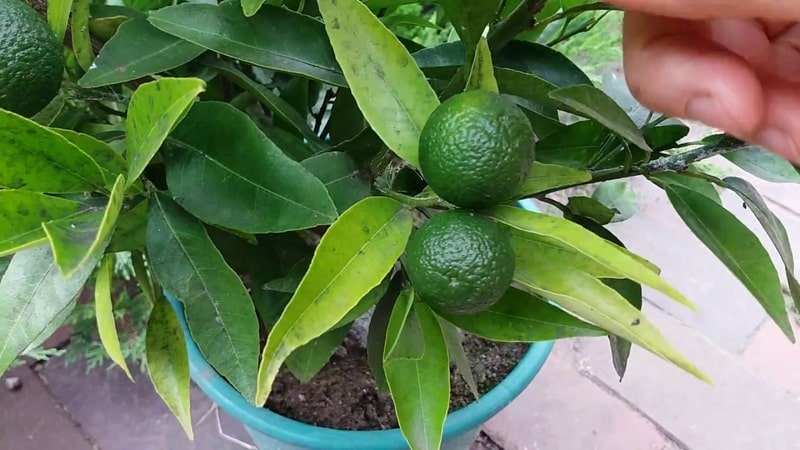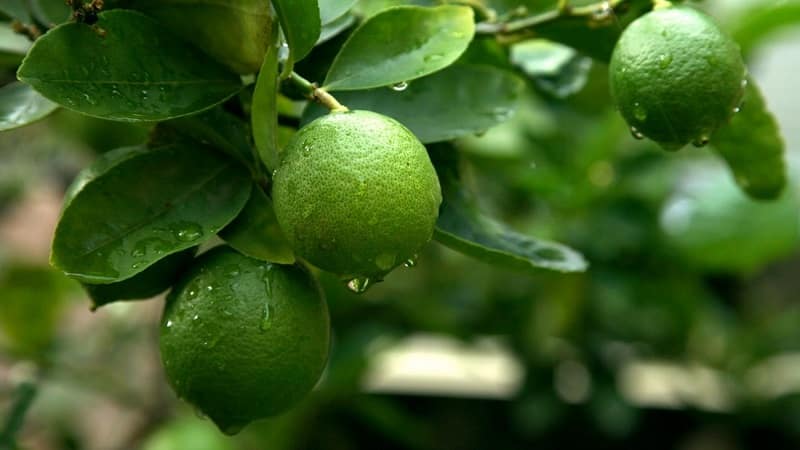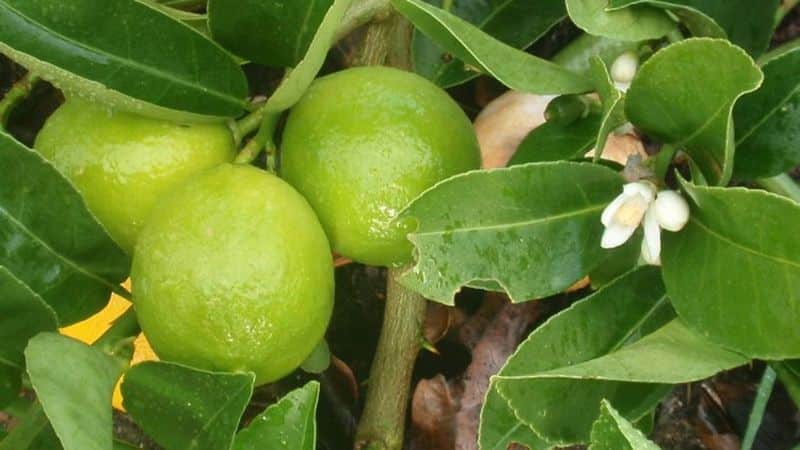How to grow lime from a seed or cutting at home
Lime is a citrus fruit, a relative of lemon. It has a yellow-green or dark green skin and greenish flesh. The fruit contains a large amount of vitamins C, A and B. Its taste is less sour than lemon, and its aroma is more tart and reminiscent of tangerine.
The plant is unpretentious. It is not demanding on the composition of the soil and produces a harvest already in the 3rd year of life. It is easy to grow in a pot at home from cuttings or seeds. Read on to learn how to plant limes and how to care for them.
The best lime varieties to grow in a pot at home
Indoor lime grown from seeds or cuttings. If planting material is taken from fruit purchased in a regular supermarket, it will not be possible to determine the plant variety. Stores usually sell fruits of hybrids that are not suitable for breeding.
Cuttings and seeds purchased at a specialty store can produce varietal limes in a pot. In this case, you can choose the most suitable variety.
For growing at home, choose varieties that are characterized by low growth and unpretentiousness:
- Santa Barbara;
- Mexican;
- Palestinian;
- Tahiti;
- Pomeranian;
- Rangipur;
- Calamansi;
- Kaffir.
Growing limes from seeds at home
Growing a lime from a seed is a longer and more complex process than planting a cutting. This method allows you to get strong and hardy plants that will bear fruit longer.
You can plant lime seeds in your apartment all year round. In winter and autumn, you will need a phytolamp, which is turned on for 5-6 hours. If you plant the seed in the second half of February, you will not need to additionally illuminate the lime. Therefore, it is recommended to start growing the plant in late winter or early spring.
note! When grown from seed, lime begins to bear fruit 4-5 years after planting.
Seed selection and preparation
Each lime contains about 4 seeds. If you decide to buy fruits in the store, you will have to take several pieces in order to collect a sufficient amount of planting material.
The fruits must be elastic, regular in shape, free from spots, damage, rot, mold and other signs of disease.
The collected bones are prepared:
- Washed from the pulp and sorted. Select dense, light (white or cream) seeds without dark spots or damage. Soft and empty seeds are thrown away.
- Disinfect – soak for 30 minutes. in a light pink solution of potassium permanganate or hydrogen peroxide.
- To stimulate germination and make seedlings stronger and more resilient, the seeds are soaked for 30-60 minutes. in humic fertilizers.
The treated seeds are allowed to dry and then planted in prepared soil.
Advice. Some gardeners recommend carefully sawing down the hard shell of the seed so as not to damage the cotyledons - this will speed up germination.
Pot and soil
In order for the seeds to germinate quickly and the seedlings to feel comfortable, it is important to use the correct soil for planting. Lime loves fertile, loose soil. In heavy soil, the plant begins to hurt and rot.
The easiest option is to buy a universal soil mixture at a gardening store, mixing it in a 2:1 ratio with river sand. They prepare the soil themselves. To do this take:
- garden soil - 1 part;
- humus – 1 part;
- sand - 1 part.
A glass of ash is added to a bucket of the mixture - it normalizes acidity and acts as an additional fertilizer.
Advice. It is recommended to prepare a large amount of soil mixture at once; it will be needed when replanting.
The soil is disinfected in one of the following ways:
- pour boiling water over;
- pour over hot copper sulfate;
- pour over with a dark pink solution of potassium permanganate;
- baked in the oven.
Be sure to use drainage: shell rock, broken ceramics, crushed expanded clay, small crushed stone.
It is recommended to sow more seeds than needed. Not all planting material will germinate. Sow the seeds in one common container, for example, a wooden box or plastic tray.
For the first picking, containers with a diameter of up to 6 cm are used. It is desirable that these are special flower pots. For each subsequent transplant, take a container 3-5 cm larger than the previous one.
The containers are also disinfected by soaking them in a dark pink solution of potassium permanganate for half an hour or dousing them with boiling water.
Important! The bottom of your lime growing container should have drainage holes. Otherwise, the water will stagnate.
Planting and care during germination

Step-by-step instructions on how to grow lime from a seed at home:
- A 1 cm thick layer of drainage is poured onto the bottom of the box, the rest of the volume is filled with soil.
- The soil is moistened with a spray bottle with warm water.
- The seeds are buried 1.5-2 cm into the ground, with a distance of at least 5 cm between them.
- After planting, the soil is watered, the boxes are covered with film and put in a warm place.
Seeds germinate from 3 weeks to 2 months. Until this moment, the crops should be under the film. The soil is moistened as it dries using a spray bottle with warm water. Every day the film is opened slightly for 30-60 minutes. for ventilation.
After seed germination, the duration of ventilation is increased, and after a week the film is completely removed.
Shoots are placed on the windowsill. The east or west side of the apartment is best suited. If you place a lime near a south window, the immature plants will have to be shaded during the day. On the north side, the seedlings will not have enough natural light.
Water the sprouts from a spray bottle with warm, settled water as the soil dries. Not only the soil is wetted, but also the plants themselves.
It is important to protect the seedlings from drafts. Otherwise, they will get blackleg or die. The ideal temperature during this period is considered to be +25…+26°C. Minimum temperature – +12°С.
When 2-3 true leaves appear on the seedlings, they are transplanted into individual pots. The strongest specimens are selected for further cultivation. They are distinguished by an elastic thick stem, bright leaf color, and short internodes.
A centimeter layer of drainage is poured onto the bottom of the pot for replanting the lime. The rest of the volume is filled with soil so that 1-2 cm remains to the edge of the pot.
The seedling is carefully removed from the common box using a wooden stick or spoon, being careful not to damage the roots. The plant is transplanted into a pot without deepening the root collar. After transplanting, the lime is watered with warm, settled water and allowed to take root for at least two days away from the sun.
Planting and rooting cuttings

Growing limes from cuttings is much easier than from seeds. In this case, the tree will begin to bear fruit already in the third year after planting.
Buy lime cuttings at a specialty store. This allows you to select the desired variety. You can also ask your friends who grow this tree for planting material.
Specialized stores sell shoots ready for planting. To make your own planting material, select a young branch in the upper part of the tree and cut it at an angle of 45° with pruning shears or a construction knife. The resulting cutting should have a length of 10-15 cm and 5 healthy vegetative buds.
Before planting, the greens on the cuttings are torn off, leaving 2-3 of the largest leaves. If the cutting is not planted immediately after separation from the mother bush, the cut must first be renewed at the same angle.
The cutting is placed at the cutting site in the “Kornevin” solution for 10-12 hours. This stimulates root germination.
To root the cuttings, the soil mixture used for germinating seeds is suitable. However, sometimes they take ordinary disinfected sand.
The shoot is planted in moist soil so that it does not fall over without support. It is convenient to use the cut-off bottom of the bottle as a container for germinating roots. The top of the bottle is covered with a seedling to create greenhouse conditions.
To germinate, lime requires a temperature of +25...+26°C and high humidity. The top of the bottle is removed for 30-60 minutes. for ventilation every day. Every day the sand is moistened, and the plant is sprayed with warm, settled water.
The cuttings will take root in about a month. After this, the ventilation time is increased, gradually accustoming the plant to room conditions. Then the top of the bottle is removed.
2 months after planting, the seedling is transplanted into a pot with a diameter of 6-8 cm. The container is filled with drainage and universal soil mixed with sand. The rooted petiole is immersed in it so that it is covered with soil 1 cm above the level of the upper roots. After this, the soil is watered.
Rules for caring for indoor lime

It is easier to grow limes at home than in a greenhouse. However, indoor plants also need attention. Next, we will tell you how to properly care for lime so that the plant blooms and bears fruit.
Lighting
The tree needs 12 hours of daylight. It is not recommended to leave it in direct sunlight. To achieve optimal lighting, the plant is placed on a western or eastern windowsill. If the lime is on a south-facing window, it is removed from the windowsill during the day to protect it from the scorching sun. It is not necessary to highlight adult plants in winter, since at this time the tree is dormant.
Temperature
In summer, the optimal temperature for growing lime is considered to be +26…+30°C. In winter, it is recommended to reduce this indicator to +19…+22°С.
Humidity
Humidity should be at least 80%. To provide the tree with the necessary conditions in summer, spring and autumn, the tree is sprayed with water at room temperature daily. In winter, this is done only if the plant is standing near the radiator. It is recommended to place several containers of water or a humidifier in the room.
Watering
The plant is watered as the top layer of soil dries, usually once every 2 days. In winter, the amount of watering is reduced to once a week.
Cleaning
Once a week, wipe the lime leaves with a damp cloth. Once every 14 days, the tree is washed in the shower.
Bloom
When the tree blooms for the first time, all the inflorescences are cut off.This will allow him to maintain strength and bear fruit in the future.
Pollination
To increase the number of ovaries, limes are pollinated artificially. To do this, pollen is spread between flowers with a soft brush or cotton swabs.
Fruiting
During the first fruiting, 2-3 most developed ovaries are left on the plant. Otherwise, the lime will drop all its fruits. Next time, leave 2 times more ovaries. During subsequent fruiting periods, all set fruits are left behind.
Transplants
Before the first fruiting, limes are harvested annually. To do this, it is taken out of the pot along with the soil and reloaded into a larger pot, adding the missing soil and not deepening the root collar. When the tree begins to bear fruit, it is replanted once every 3 years. At the same time, old roots are cut off.
Feeding
Lime loves fertile soil. To get a bountiful and tasty harvest, it must be fed. During the warm period, fertilize the plant once every 7-14 days. There is no need to feed the tree in winter.
How to feed limes to make the fruits tastier:
- Potassium-phosphorus fertilizers. Add 1 kg of ash to 5 liters of water, leave for 24 hours, then use it to water the plant. Fertilizer is prepared from superphosphate (15 g) and potassium nitrate (10 g) per 5 liters of water. The product is not only watered, but also sprayed on the tree.
- Decoction of herbs: nettle, chamomile, horsetail.
- Food waste. This can be water infused with banana peels (5 banana peels per 3 liters of water), leftover tea and coffee.
- Beer. It is useful to water citrus fruits with beer and spray the leaves with the drink.
- Fish broth. 250 g of fish waste is boiled for half an hour in 2 liters of water. The resulting broth is filtered and used to water the lime.
It is recommended to alternate the fertilizers described.The day before fertilizing, water the lime. They also use special fertilizers for citrus fruits “BioMaster”, ASB Greenworld, “Zdraven”.
Trimming
To achieve fruiting of the lime, it is important to form it correctly. Use the following scheme:
- When the tree reaches the desired height, the apical shoot is cut off. This stimulates the formation of lateral branches.
- The next year, cut the shoots to 1/3 of their length. The crown is given the desired shape by cutting.
- Next, remove all old, weak and damaged shoots. Strong branches are removed only if they thicken the crown.
Diseases and pests

Household limes are sometimes attacked by pests. The most common are aphids, scale insects and spider mites. They are recognized by the following characteristics:
- lime greens turn yellow, wither and fall off, the plant sheds its inflorescences, shoots do not develop;
- a gray or white coating forms on the leaves;
- a cobweb appears on the underside of leaf blades and young shoots;
- small insects of green, red or red-brown color are noticeable;
- Film formations form in the area of internodes and on young shoots.
If any of the described signs appear, wash the lime in the shower with warm water and then spray it with soapy water. To prepare it, dissolve a quarter of a piece of laundry soap in 2 liters of water. If this does not help, use chemicals, for example, Actellik.
The most common disease of indoor lime is homoz. Its main symptom is the appearance of cracks on branches and young shoots. If the plant is not treated, it will die. To combat infection, limes are sprayed with copper sulfate. Damaged areas are smeared with garden varnish.
This is interesting:
Step-by-step guide: how to plant an orange from a seed at home.
Conclusion
Growing lime at home is a process that requires attention from the grower. The plant is often fertilized, watered, fed, and the crown is formed. If you follow the rules of care, it takes root easily, grows quickly and does not get sick.
Lime is considered an unpretentious plant. A gardener's mistakes rarely lead to his death. However, the tree bears fruit only with proper care.